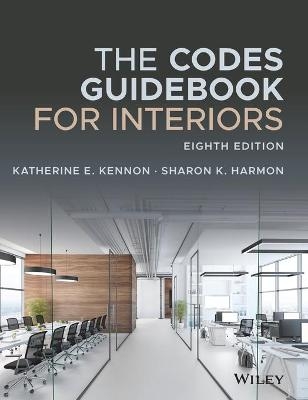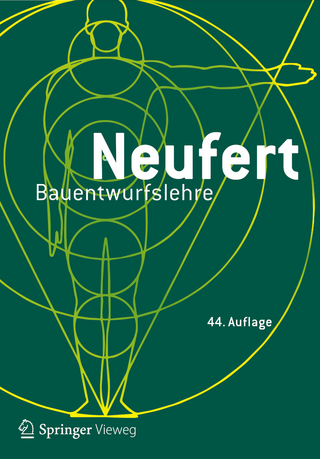
The Codes Guidebook for Interiors
John Wiley & Sons Inc (Verlag)
978-1-119-72095-9 (ISBN)
Updates to the Eighth Edition include:
Explanations of code requirements, highlighting the latest changes in the 2018 and 2021 ICC codes, including the International Building Code and the NFPA’s Life Safety Code
Clarifications to how and when the ADA, ABA and the ICC/ANSI accessibility requirements will apply to a project
Introduction to the codes and standards that address sustainability in typical projects
In-depth examinations of fire and smoke resistant assemblies, fire protection systems, and plumbing and mechanical requirements
A companion website with printable study flashcards, instructor’s manual, and PowerPoint slides for use in academic settings
Digital and printable code checklists that can guide code research for professional projects and use in a design studio
Current, practical, and relevant to nearly any interior or architectural project, The Codes Guidebook for Interiors provides invaluable insight and reference for both student and professional interior designers and architects.
Katherine E. Kennon is a professional architect and principal at the Architect WORKSHOP. She has extensive experience in commercial, healthcare, and residential projects. She continues to teach as an adjunct instructor in interior design and architectural programs on the subjects of codes, accessibility, and design. She has conducted various seminars on design, building codes, and accessibility throughout the US. Sharon K. Harmon has more than twenty-five years’ experience in interior design and project management. She is owner and founder of Life Design for Health, which combines her experience with interior design with her strong interest in natural health.
Inset Index xiii
Preface xv
Acknowledgments xix
How to Use This Book xxi
Abbreviations xxxi
Chapter 1: About the Codes 1
A Brief History 2
Code Publications 3
Federal Regulations 22
Standards Organizations 25
Special Use Codes 34
Research: Using the Codes 35
Chapter 2: Accessibility 37
A Brief History 38
Codes and Standards 40
Federal Regulations 43
Level of Accessibility 50
Enforcement and Responsibility 55
Research: Using the Codes 58
Documentation 59
Chapter 3: Occupancy Classifications And Loads 61
Understanding Occupancy Classifications 62
Description of Occupancies 64
Other Occupancy Considerations 84
More Than One Occupancy Type 87
Accessibility Requirements 95
Determining Occupant Loads 99
Using the Occupant Load 112
Research: Using the Codes 113
Documentation 114
Chapter 4: Construction Types And Building Sizes 117
Understanding Construction Types 117
Identifying Construction Types 123
Sustainability Considerations 128
Understanding Building Height and Area 131
Research: Using the Codes 139
Documentation 142
Chapter 5: Means of Egress 143
Means of Egress System 144
Exit Accesses 149
Exits 169
Areas of Refuge 178
Exit Discharges 181
Means of Egress Capacity 183
Arrangement of Exits 198
Signage 209
Emergency Lighting and Communication 213
Research: Using the Codes 214
Documentation 218
Chapter 6: Fire and Smoke Resistant Assemblies 221
Passive Systems 222
Active Systems 222
Exiting Systems 222
Compartmentation in a Building 224
Fire Walls 225
Fire Barriers, Horizontal Assemblies, and Fire Partitions 226
Smoke Barriers and Smoke Partitions 243
Opening Protectives 246
Through- Penetration Protectives 260
Test Ratings 266
Using Rated Materials and Assemblies 268
Sustainability Considerations 271
Research: Using the Codes 273
Documentation 275
Chapter 7: Fire Protection Systems 277
Detection Systems 278
Alarm Systems 285
Extinguishing Systems 291
Sustainability Considerations 306
Research: Using the Codes 307
Documentation 309
Chapter 8: Plumbing and Mechanical Requirements 311
Number of Plumbing Fixtures 312
Plumbing Fixture Requirements 322
Toilet and Bathing Facilities 333
Plumbing Sustainability Considerations 349
Mechanical Requirements 350
Mechanical Sustainability Considerations 358
Research: Using the Plumbing and Mechanical Codes 360
Documentation 366
Chapter 9: Electrical and Communication Requirements 367
Electrical Components and Devices 368
Grounding and Circuit Interrupters 382
Light Fixtures 386
Required Electrical Systems 390
Electrical Sustainability Considerations 393
Communication Components and Devices 399
Types of Communication Systems 406
Communication Sustainability Considerations 413
Research: Using the Electrical Codes 414
Research: Using the Communication Codes 416
Documentation 417
Chapter 10: Finish and Furniture 419
Types of Finishes and Furnishings 420
Standards and Testing 423
Determining Finish Requirements 448
Obtaining Test Results 457
Accessibility Requirements 463
Acoustical Partitions and Materials 470
Decorative Materials 473
Signage 475
Other Code Restrictions 477
Sustainability Considerations 480
Research: Using the Codes 486
Documentation 489
Chapter 11: Code Officials and the Code Process 491
Authority Having Jurisdiction 492
Code Review and Enforcement 496
The Code Process 498
Documentation 512
Technology and Process 521
Minimum Requirements and Best Practices 523
Appendix A: Sustainability 525
Green Rating Systems 527
Sustainable Standards and Certification Programs 532
Life Cycle Assessments 536
Environmental Product Declarations 538
Tools and Resources 538
Appendix B: Existing and Historic Buildings 541
Existing Buildings 543
Historic Buildings 547
Sustainability Considerations 549
Appendix C: Family Residences 551
Construction Types and Building Size 552
Means of Egress 553
Fire and Smoke Resistance 554
Fire Detection and Protection 555
Plumbing 557
Mechanical 557
Electrical and Communication 559
Finishes and Furniture 561
Accessibility Considerations 562
Sustainability Considerations 562
Glossary 565
Index 587
| Erscheinungsdatum | 07.03.2022 |
|---|---|
| Verlagsort | New York |
| Sprache | englisch |
| Maße | 193 x 239 mm |
| Gewicht | 1089 g |
| Themenwelt | Technik ► Architektur |
| ISBN-10 | 1-119-72095-8 / 1119720958 |
| ISBN-13 | 978-1-119-72095-9 / 9781119720959 |
| Zustand | Neuware |
| Haben Sie eine Frage zum Produkt? |
aus dem Bereich


